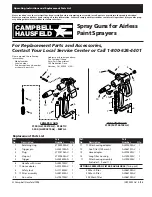
11
EN
RISKS TIED TO SPRAY GUN CLEANING
- The spray gun must be cleaned
exclusively
by qualified and trained personnel;
- Before disassembling and cleaning, make sure the spray gun has been disconnected the power supply system!
Danger! Serious risk of injury from the escape/leak of compressed air and/or of spray substances!
- For cleaning purposes acid or alkaline substances (bases, paint removers, etc.) must never be used!
Do not use highly corrosive and abrasive products.
- Use neutral cleaning solvents/detergent solutions (pH 6 to 8);
-
Do not immerse
the spray gun in a bath of solvents/detergent solutions. Solvents/detergent solutions must never enter
the air channels, which can otherwise compromise the functionality and durability of the spray gun;
-
Do not use ultrasonic cleaning systems;
- After cleaning operations, dry and blow the gun, nozzle, cap, and cup with clean compressed air!
- Never use metal or other objects that could damage the holes in the nozzle and cap!
- For models equipped with a removable diffuser, do not blow compressed air through internal spray gun passages (for
example from the air supply) if the nozzle has not been previously tightened: danger of diffuser projection.
SPECIAL CONDITIONS FOR SAFE SPRAY GUN USE
With the use of the spray gun, Thermal Hazards can derive from:
- the use of heated compressed air;
- the application of heated coating and finishing products;
- an overheated environment.
In these situations, the surface of the spray gun reaches, at most, the temperature of the heated compressed air, of the
heated coating and finishing product in use, or of the overheated environment.
In these conditions, PAY ATTENTION to the following information:
- the spray gun’s Surface Temperature must not exceed the burn threshold of 43° C (UNI EN 1953 paragraph 5.4). If
this is the case, hand protections must necessarily be used (for example, heat-insulating and antistatic gloves);
- the surface temperature of the spray gun must never exceed 85° C, a temperature sufficiently lower than the
Minimum Ignition Temperature
(
MIT
) of the solvents commonly used for painting in bodywork, carpentry,
woodworking, and industry;
- if in doubt, ask the product’s dealer for information on the solvent’s
MIT
before using it.
Summary of Contents for 050327
Page 2: ...2 ...
Page 7: ...7 IT C U E G A R K I P L Cg M E G R K I P L Cg C M E E D ...
Page 13: ...13 EN C U E G A R K I P L Cg M E G R K I P L Cg C M E E D ...
Page 19: ...19 DE C U E G A R K I P L Cg M E G R K I P L Cg C M E E D ...
Page 25: ...25 FR C U E G A R K I P L Cg M E G R K I P L Cg C M E E D ...
Page 31: ...31 ES C U E G A R K I P L Cg M E G R K I P L Cg C M E E D ...
Page 37: ...37 PT C U E G A R K I P L Cg M E G R K I P L Cg C M E E D ...
Page 43: ...43 RUS C U E G A R K I P L Cg M E G R K I P L Cg C M E E D ...












































